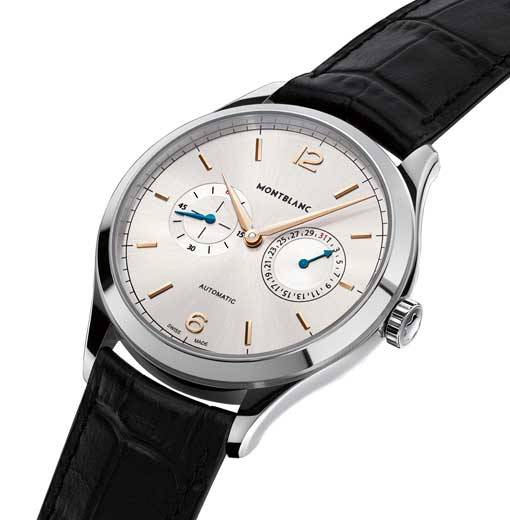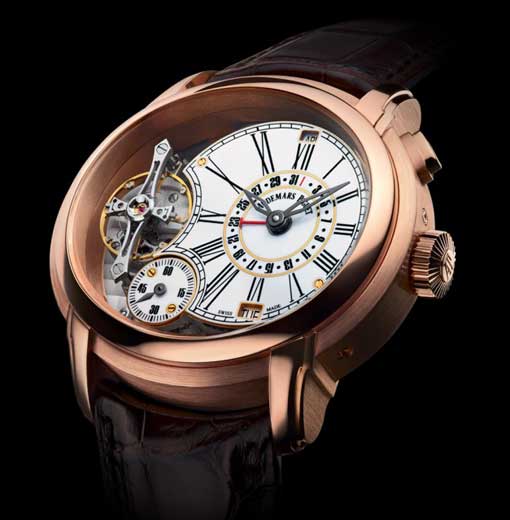The date is a fundamental item of information in our lives, as well as a complex calculation. For while Monday always follows Sunday, the first day of the month does not always follow the 30th or the 31st of the previous one. The Gregorian calendar is full of exceptions and a watch movement’s ability to keep close track of them determines both its complexity and its prestige. The choice of indications, their form and their exhaustiveness combine with the aforementioned first factor to make calendars a real maze that is well worth taking a closer look at.
The day is probably the only component of the date that does not involve any particular issues. Its sequence is short and unchanging. It never appears alone and is accompanied at least by the date. The latter, despite being an apparently straightforward two-digit number, is already a complex business in itself. It may be indicated by a date sweeping over a circular graduation, or even in a sector in the case of a retrograde display. It is generally borne by a disc that makes rotational jumps beneath the dial and appears through a window referred to as an aperture. In some cases, this aperture is larger than average and is thus referred to as a large, big or outsized date. One specific version is composed of two discs – one for the tens and the other for the units – and known as a large twin-aperture date display. This option is available whatever the calendar.

The complete or full calendar represents the most basic level of mechanical complexity that it is by nature often inaccurate in that it shows the day, the date and month – with all months lasting an identical 31 days. It therefore requires manual adjustment five times a year.
The annual calendar is the first step towards automated calendar calculation. This is the ideal that watchmakers have been pursuing for 500 years: describing the reality of time as it passes without any need for manual adjustments. Its distinctive feature lies in its ability to tell the difference between months with 30 days and those with 31. Its only source of error is the transition from the last day of February to March 1st and it thus requires only one correction per year.
The quadrennial calendar is one of the least known in the world and yet it has been around for decades. It takes account of the length of each month of the year, whether they last 28, 30 or 31 days. However, its ability to display the correct date throughout the year has one particular limit: leap years, in which February is one day longer than usual. This type of calendar therefore requires correction every four years.

The perpetual calendar is the best-known of the more evolved calendars. It has existed for centuries and derives its prestige from its ability to calculate the duration of all months of the year and for every year. To achieve this, it is equipped with an indicator that other types do not possess: a four-part subdial that shows whether or not the year in progress is a leap year. Years that are multiples of four are longer and this type of calendar takes account of this in its calculations.
However, the exceptions to the Gregorian calendar are particularly subtle. In order to reconcile our legal time exactly with time as it is indicated by the sun, each century comprises 24 years rather than 25: the century years, marking the transition from one century to the next are not leap years even though they are multiples of four. This exception is taken into account by the rarest and most sophisticated type of calendar, the secular calendar, produced by barely four different brands worldwide. It comprises gear trains intended to serve their purpose only once every 100 years.

As an additional refined touch, a few rare watches (of which only a handful are in circulation) also display the current year in four-digit mode. An equally small number of brands also offer models displaying the number of the week, as used in professional circles. This option is often combined with perpetual calendars, although not necessarily.
The date is not restricted to these indications, which relate to the legal and conventional time that we use in daily life. The Moon is another indication of the passing of time and is also important, which is why the indication of the moon-phase can show up in almost all existing calendars, albeit with variable degrees of precision. The lunar cycle is like the other natural cycles: it is not an exact multiple of the 24 hours in our day. The ability of a moon-phase display to keep exact track of reality also varies in terms of accuracy. And if one wishes to travel even further into space, some watches also follow the path of the planets or even the entire solar system.
The Gregorian calendar is not however the only official calendar in use. There are three other less common ones that are used in parallel with it. Their importance stems from their de facto use, from their cultural importance, and from their intrinsic horological value. The Hegirian calendar is lunar, the Hebrew calendar is lunisolar, and the traditional Chinese calendar is base on the lunisolar cycle complemented by symbolic years following an irregular cycle. The rare and exceptional models comprising these calendars often result from special commissions.










